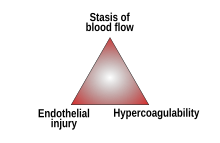Virchow's triad
| Virchow's triad | |
|---|---|
 | |
| Virchow's triad | |
| Differential diagnosis | thrombosis |
Virchow's triad or the triad of Virchow (/ˈfɪərkoʊ/) describes the three broad categories of factors that are thought to contribute to thrombosis.[1]
- Hypercoagulability
- Hemodynamicchanges (stasis, turbulence)
- Endothelialinjury/dysfunction
It is named after the renowned German physician Rudolf Virchow (1821–1902). However, the elements comprising Virchow's triad were not proposed by Virchow. Neither did he ever suggest a triad to describe the pathogenesis of venous thrombosis. In fact, it was not until decades after Virchow's death that a consensus was reached proposing that thrombosis is the result of alterations in blood flow, vascular endothelial injury, or alterations in the constitution of the blood. Still, the modern understanding of the factors leading to embolism is similar to the description provided by Virchow. Virchow's triad remains a useful concept for clinicians and pathologists alike in understanding the contributors to thrombosis.[2]
The triad
The triad consists of three components:
| Virchow's[3] | Modern | Notes |
|---|---|---|
| Phenomena of interrupted blood-flow | Stasis [4] | The first category, alterations in normal blood flow, refers to several situations. These include venous stasis, long surgical operations, prolonged immobility (whilst on a long plane or car ride, bed bound during hospitalization), and varicose veins. The equivalence of Virchow's version and the modern version has been disputed.[5] |
| Phenomena associated with irritation of the vessel and its vicinity | Endothelial injury or vessel wall injury | The second category, injuries and/or trauma to monocytes in chronic inflammation .
|
| Phenomena of blood-coagulation | Hypercoagulability
|
The last category, alterations in the constitution of blood, hypercoagulability (excessively easy clotting of blood).
|
History
The origin of the term "Virchow's Triad" is of historical interest, and has been subject to reinterpretation in recent years.[7] While both Virchow's and the modern triads describe thrombosis, the previous triad has been characterized as "the consequences of thrombosis", and the modern triad as "the causes of thrombosis".[8]
Rudolf Virchow elucidated the etiology of
Although the concept of the triad is usually attributed to Virchow, he did not include endothelial injury in his description.[12] This has been attributed to a dispute Virchow had with Jean Cruveilhier, who considered local trauma of primary importance in the development of pulmonary artery thrombosis.[13][14]
References
- ISBN 978-0-7817-8355-2.
- PMID 18783400.
- ^ ISBN 978-1-4020-6649-8. Archived from the original on 2022-10-15. Retrieved 2021-12-06.)
{{cite book}}: CS1 maint: multiple names: authors list (link - PMID 15692260.
- ^ "Further reflections on Virchow's triad". Archived from the original on 2016-03-05. Retrieved 2009-02-10 – via Free Online Library.
- PMID 15692259.
- ^ Dickson, B.C. (2004). "Venous thrombosis: on the history of Virchow's triad" (PDF). University of Toronto Medical Journal. 81: 166–171. Archived from the original (PDF) on 2016-03-05. Retrieved 2012-05-09.
- ^ "Response: further reflections on Virchow's Triad". Archived from the original on 2016-03-03. Retrieved 2009-02-10 – via Free Online Library.
- ISBN 0-88135-113-X.
- ^ "Virchow's triad?". Archived from the original on 2016-03-04. Retrieved 2009-02-10 – via Free Online Library.
- ^ Wiseman R. Several Chirurgical Treatises. (2nd ed.) London, Norton and Macock, 1686, pp. 64–66.
- Who Named It?
- ^ "Virchow's triad revisited". Archived from the original on 2016-03-03. Retrieved 2009-02-10 – via Free Online Library.
- ^ Aschoff L. Thrombosis, in Lectures on Pathology. New York, Paul B. Hoeber, Inc., 1924, pp 253–278.
